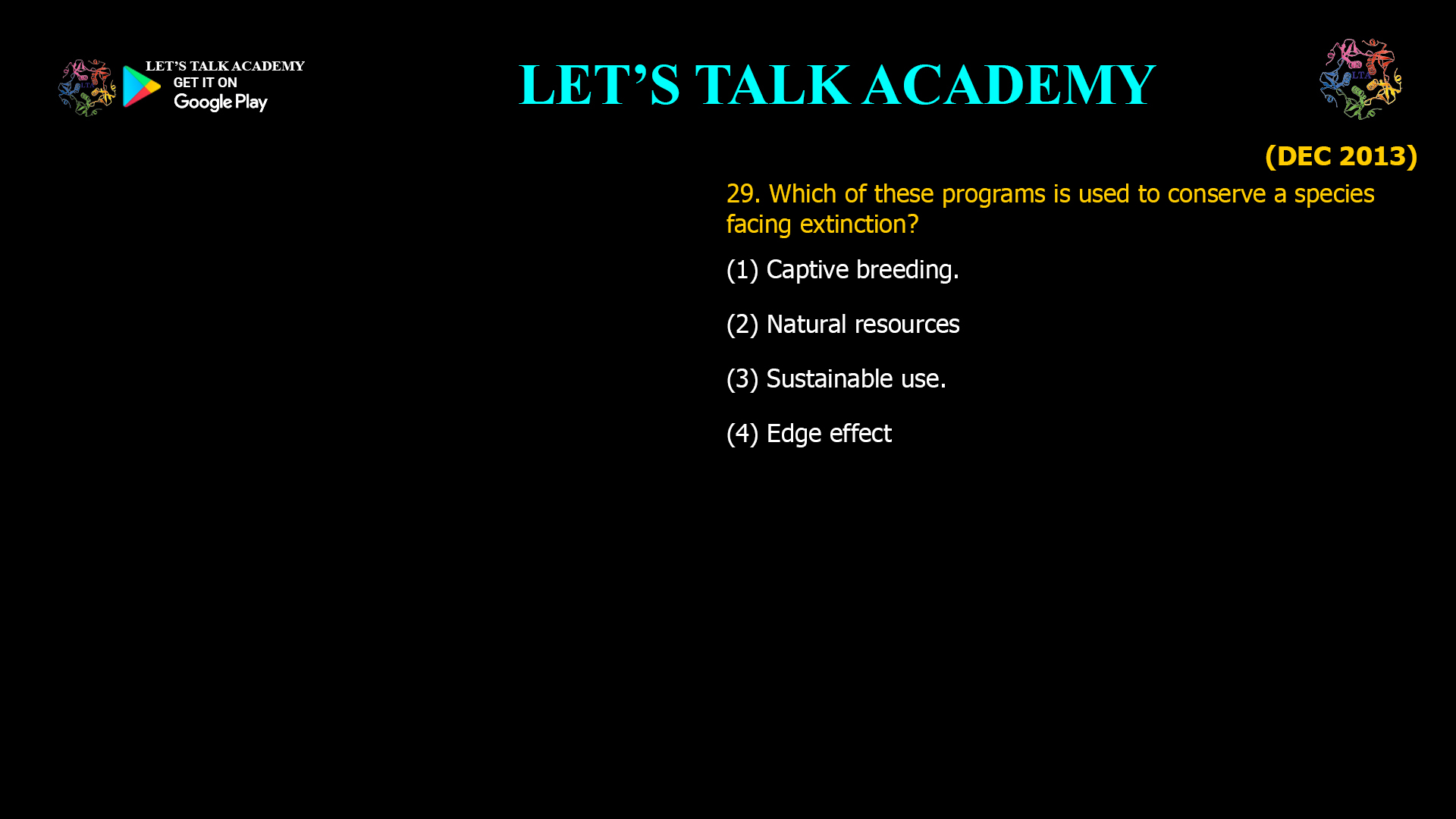- Which of these programs is used to conserve a species facing extinction?
(1) Captive breeding. (2) Natural resources
(3) Sustainable use. (4) Edge effectThe rapid loss of biodiversity is one of the most pressing environmental challenges of our time. As habitats shrink and threats like poaching, pollution, and climate change intensify, many species teeter on the brink of extinction. Among the most effective strategies to conserve species facing extinction is captive breeding—a scientifically managed process that has become a beacon of hope for countless endangered animals and plants.
What is Captive Breeding?
Captive breeding, also known as conservation breeding, involves raising and breeding endangered species in controlled environments such as zoos, wildlife reserves, and specialized breeding centers. The primary aim is to increase the population of species that are critically endangered, with the ultimate goal of reintroducing healthy individuals back into their natural habitats when conditions allow136.
Why Is Captive Breeding Necessary?
Natural habitats are being lost at an alarming rate due to urbanization, agriculture, and industrial development. For some species, in-situ conservation—protecting them in their natural environment—is no longer sufficient. When wild populations become too small or fragmented to survive, captive breeding offers a crucial safety net26.
Key reasons captive breeding is necessary include:
-
Preventing Extinction: By maintaining a viable population in captivity, species can be saved from disappearing entirely.
-
Restoring Populations: Captive-bred individuals can be reintroduced to bolster wild populations or re-establish species in areas where they have vanished.
-
Preserving Genetic Diversity: Careful management helps maintain the genetic health of the species, reducing the risks associated with inbreeding46.
How Does Captive Breeding Work?
Captive breeding programs are highly coordinated efforts that require expertise in genetics, animal behavior, ecology, and veterinary care. The process typically involves:
-
Selecting Founders: The breeding population is started with as many unrelated individuals as possible to maximize genetic diversity.
-
Managing Breeding: Breeding pairs are carefully chosen to avoid inbreeding and ensure healthy offspring.
-
Simulating Natural Conditions: Facilities strive to mimic the species’ natural habitat, providing appropriate diets, shelter, and opportunities for social interaction5.
-
Preparing for Reintroduction: Animals are gradually acclimatized to wild conditions, learning essential survival skills before release.
Success Stories in Captive Breeding
Captive breeding has played a pivotal role in saving several species from extinction. Notable examples include:
-
Arabian Oryx: Once extinct in the wild, the Arabian Oryx was successfully bred in captivity and reintroduced, now thriving in its native habitat.
-
California Condor: With only 27 individuals remaining in the 1980s, an intensive captive breeding program has increased their numbers and enabled reintroductions in the wild.
-
Przewalski’s Horse: The last wild horse species, once extinct in the wild, has been brought back through captive breeding and now roams free again in Mongolia6.
Challenges of Captive Breeding
While captive breeding offers hope, it is not without challenges:
-
Genetic Bottlenecks: Small founder populations can lead to reduced genetic diversity and inbreeding.
-
Behavioral Issues: Animals raised in captivity may lack the skills needed to survive in the wild, such as hunting or avoiding predators.
-
High Costs: Maintaining breeding programs requires significant financial and human resources.
-
Ethical Concerns: The welfare of animals in captivity and the potential for domestication are ongoing debates14.
The Role of Zoos and Conservation Centers
Modern zoos and conservation centers are at the forefront of captive breeding efforts. They not only provide the facilities and expertise needed for breeding but also play a vital role in public education and scientific research. By raising awareness and fostering a connection between people and wildlife, these institutions help build support for conservation initiatives17.
Future Directions
As threats to wildlife continue to grow, captive breeding will remain an essential tool for conservation. Advances in genetics, reproductive technology, and habitat restoration are improving the success rates of these programs. International collaboration and information sharing are also key to ensuring the long-term survival of endangered species.
Conclusion
Captive breeding stands as a lifeline for species facing the threat of extinction. By combining scientific knowledge, careful management, and global cooperation, these programs have already saved several species and hold the promise of rescuing many more. As we strive to protect our planet’s biodiversity, captive breeding will continue to play a vital role in ensuring that future generations inherit a world rich in wildlife and natural wonders.
-




2 Comments
Prena Ghangas
October 28, 2025Captive breeding
Kajal
November 5, 2025Captive breeding